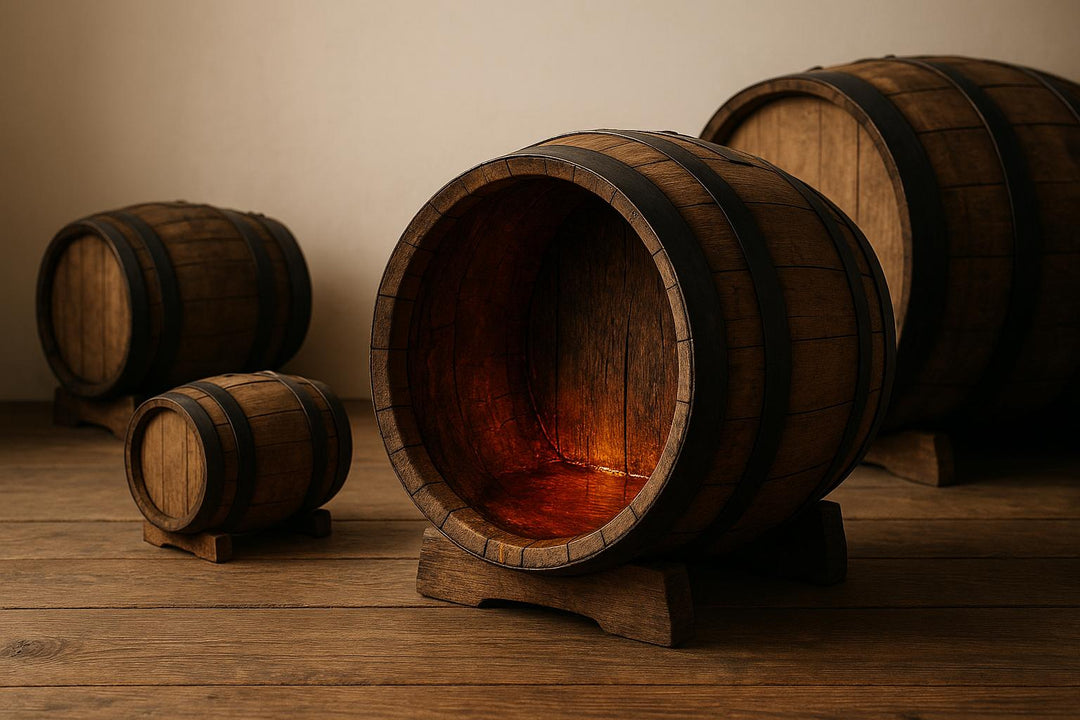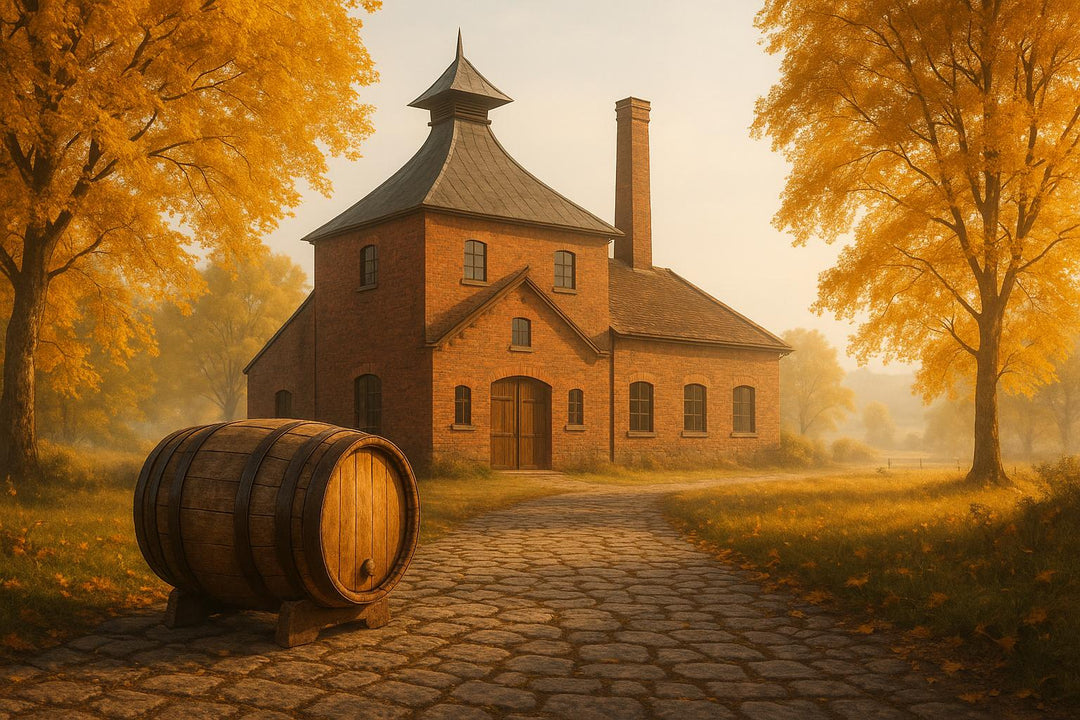When distilleries in the UK gain heritage status, they are legally protected for their architectural and historical importance. This recognition not only preserves the physical structures but also safeguards age-old whisky-making techniques and practices. Here's what you need to know:
- Heritage Status Explained: Buildings are classified into Grade I, II*, or II based on their historical or architectural value.
- Why It Matters: It protects regional whisky traditions, supports local jobs, and boosts tourism. In 2022, Scotch whisky exports hit £6 billion, with the industry sustaining over 42,000 UK jobs.
- Criteria for Approval: Age, historical significance, rarity, and the preservation of original features are key factors.
- Listing Process: Anyone can nominate a site. Applications are reviewed by experts, with decisions taking up to six months.
- Post-Listing Challenges: Owners must balance preservation with modern use, often integrating modern systems discreetly.
Heritage-listed distilleries, like Ardbeg, demonstrate how preserving history can coexist with business success, strengthening the whisky industry and local economies alike.
Breathing New Life into an 1872 Landmark: A Conversation with 1879 Distilling

Criteria for Heritage Designation
Heritage designation in the UK is governed by strict statutory criteria, ensuring that only buildings and structures with genuine historical and architectural value receive official protection. For Scotland’s distilling industry, these criteria also reflect the unique legacy of whisky production.
Historical Significance
The historical value of a building plays a crucial role in its eligibility for heritage listing. Age and continuity are key factors. Buildings constructed before 1700 that retain a significant portion of their original structure are automatically considered for listing [1]. Most buildings from 1700 to 1840 are also listed, while those built after 1840 are subject to more selective criteria. For structures dating to post-1945, the selection process becomes even more rigorous [1].
When it comes to whisky distilleries, their historical roots align closely with Scotland’s distilling heritage. The first recorded mention of distilling in Scotland dates back to 1494 [3]. Many distilleries today occupy sites that were once used by smugglers centuries ago [3]. By the 1820s, authorities were confiscating as many as 14,000 illicit stills annually, highlighting the widespread activity that laid the groundwork for Scotland’s whisky heritage [3].
A distillery’s connection to historical figures or events can further bolster its heritage case. For example, links to Robert Burns, Scotland’s national poet and a former tax collector, can tie a distillery to broader cultural narratives [3].
Another key consideration is the continuity of traditional practices. As the Scotch Whisky Association notes:
"Whatever you call Scotland's national drink, and whichever Scotch you discover, you know that it is a product of quality, crafted in Scotland, with a unique heritage stretching back more than 500 years." [3]
This enduring legacy of craftsmanship underscores the historical importance of distilleries, extending their significance beyond architectural considerations.
Building and Structure Requirements
Heritage designation also hinges on the architectural integrity of a site. Listing encompasses not just the building’s exterior but also its interior, fixtures, and fittings [1].
Interestingly, the state of repair is not a deciding factor for listing [1]. This means that even distilleries in poor condition, including abandoned "ghost" distilleries, can qualify if they meet other criteria. This is particularly important for preserving sites that, while deteriorated, hold immense historical value.
Preserving the original fabric of a building is essential. Structures must retain key historical features to demonstrate their authenticity. Even buildings with limited visual appeal can be listed if they hold significant social or economic historical importance [1]. This flexibility ensures that industrial sites like distilleries are recognised for their heritage value, not just their aesthetic qualities.
Rarity and Special Features
Another important criterion is rarity. When numerous examples of a particular building type exist, only the most representative or historically significant ones are listed [1]. For distilleries, this means that only those with distinctive features or historical importance are likely to qualify.
National interest also plays a role. Distilleries that exemplify Scotland’s whisky-making heritage, particularly those showcasing regional characteristics, strengthen their case for heritage designation [1][4].
The preservation of original production features, such as historic equipment and traditional methods, can further enhance a distillery’s heritage value. These elements highlight the site’s role in the evolution of whisky production.
One particularly compelling example of rarity is the concept of the ghost distillery. Brora Distillery, which operated from 1819 to 1983, is a prime example. Its rare 40-year-old whisky once sold for £54,450 at auction [5]. James MacKay, Diageo’s head of rare and collectible spirits, explains:
"I think the ghost distillery offering is so special to our customers because these whiskies can simply never be made again... It feels different when you open the bottle. When you share this with your friends or guests, they'll know that they're being treated to something completely irreplaceable and finite." [5]
This irreplaceable nature adds to the heritage value of such sites, showcasing their unique contribution to Scotland’s distilling history. By combining historical significance, architectural integrity, and distinct regional features, these criteria ensure that heritage designation recognises not only the physical importance of a building but also its role in preserving Scotland’s whisky traditions.
The formal process for heritage listing, including these criteria, will be explored in the following section.
The Heritage Listing Process
The journey to becoming a heritage-listed distillery is a structured and meticulous process, designed to protect the history and significance of these sites while coexisting with modern practices.
Submitting Applications
You don't need to be the owner or hold any special credentials to nominate a building for heritage listing. In fact, anyone – whether a whisky enthusiast, a local historian, or a community group – can step forward to advocate for the preservation of a distillery [6]. This inclusive system ensures that important sites can be championed by those who value them most.
Applications are submitted to Historic Environment Scotland if the distillery is not already protected. To strengthen your case, the Designation Application Checklist can guide you in gathering essential materials, such as photographs, historical records, architectural plans (if available), and other evidence that highlights the site's importance. Timing is crucial – if the building is at risk of demolition or drastic changes, the assessment process can be expedited to provide urgent protection [6].
Once the application is submitted, it moves to a detailed review by experts.
Review and Assessment
The first step is for the relevant authority – whether it's Historic England, Historic Environment Scotland, or another body – to confirm that the application contains all the necessary information and imagery. Applications missing key details are deemed ineligible.
An initial evaluation then determines if the site warrants further investigation. Experts assess the distillery based on statutory criteria, including its historical importance, architectural condition, and uniqueness. If the site doesn't meet these criteria, a report is prepared and signed off by the Department for Culture, Media and Sport (DCMS), with notifications sent to both the applicant and the local planning authority [6]. However, if the site shows potential, the process progresses to a comprehensive assessment. This involves in-depth historical and architectural research, and sometimes a site visit by heritage specialists. The evaluation also includes consultations with key stakeholders, such as the local planning authority, the building's owner, and heritage groups, to ensure diverse perspectives are taken into account.
Final Classification and Results
The final decision-making process differs across the UK. In England, the Secretary of State for Culture, Media and Sport makes the ultimate call, following recommendations from Historic England. While the aim is to resolve most cases within 10 working days, complex applications may require more time [6]. In Scotland, Historic Environment Scotland oversees the process on behalf of Scottish Ministers. Similarly, in Wales, the system is managed by Cadw for the Welsh Ministers, and in Northern Ireland, the Historic Environment Division within the Department for Communities handles listings.
Assessment timelines are typically predictable but can vary. Historic England, for example, strives to complete evaluations within six months of receiving an application. However, this timeframe may be shortened for sites under immediate threat or extended due to high application volumes or the complexity of a case [6].
Heritage listing has immediate and lasting effects. As the legislation outlines:
"A listed building is a structure of particular architectural or historic interest deserving of special protection." [1]
This designation means that any demolition, extension, or alteration requires approval from the local planning authority [1]. Once a decision is reached, all involved parties are notified, and a copy of the recommendation report is shared.
Preservation and New Uses
When a distillery earns heritage status, the real challenge begins. Owners must carefully balance preserving its historical essence with modernising it for practical, long-term use.
Restoring Historic Features
At the heart of any heritage distillery project is the commitment to showcasing original features rather than covering them up [7]. This requires skilled craftsmanship and an eye for detail.
Restoration often involves using reclaimed materials that match the building's era, ensuring that architectural elements remain true to their origins [7]. During this process, hidden treasures like original beams, stone foundations, or intricate decorative details - long buried under years of industrial wear - can be uncovered.
Take the Old Taylor Distillery, now known as Castle & Key, as an example. When Will and Shannon Arvin, along with Wesley Murry, purchased the 113-acre site in 2014 for nearly £800,000 (about $1 million at the time) [8], they discovered stunning stonework and architectural details that had been hidden for decades. They invested millions to restore the site to its 1872 glory, and by 2018, the distillery reopened with its historical charm intact.
To keep the 19th-century aesthetics while ensuring functionality, modern systems like heating, lighting, and safety features are integrated discreetly [7]. Hidden wiring, subtle climate controls, and carefully placed amenities allow these historic buildings to operate seamlessly in the modern world without losing their vintage appeal.
Once restored, the next step is to adapt these spaces for contemporary use, ensuring their relevance and sustainability.
Modern Uses for Old Buildings
Heritage distilleries offer incredible versatility, breathing new life into old spaces. Their robust construction, originally designed to house heavy distilling equipment, makes them perfect for modern hospitality, cultural, and commercial activities.
The Gooderham and Worts Historic District serves as a prime example of how these spaces can transform into bustling mixed-use hubs [9].
The open layouts and high ceilings typical of distilleries lend themselves to a variety of uses. These spaces can host whisky tastings, corporate events, art exhibitions, or even serve as restaurants and visitor centres. This flexibility ensures operators can cater to diverse needs without compromising the historical character of the building [7].
Tourism is another major draw. In 2019, cultural tourism supported 319 million jobs and generated over £24 billion across Europe [10]. Distilleries, with their rich histories and whisky-making allure, are uniquely positioned to tap into this market.
Castle & Key is a shining example of blending heritage with modern appeal. By hiring Marianne Barnes, Kentucky's first female Master Distiller of Bourbon since Prohibition, they added a layer of historical significance to their narrative [8]. Today, the site operates as both a distillery and a tourist destination, complete with a redesigned sunken garden by Jon Carloftis that complements its industrial roots.
While modern updates enhance functionality, staying true to the site's heritage remains a priority.
Balancing Preservation and Business
Running a profitable heritage distillery while adhering to preservation guidelines is no small feat. Success lies in careful planning and finding middle ground between historical integrity and modern needs. Here's a breakdown of key considerations:
| Preservation Requirements | Business Needs | Balanced Solutions |
|---|---|---|
| Protect original architectural features | Meet modern safety standards | Use discreet fire suppression systems and accessibility features that blend with the design |
| Use period-appropriate materials | Control renovation expenses | Source reclaimed materials and train local artisans in traditional techniques |
| Maintain historical authenticity | Create adaptable spaces | Employ removable partitions and temporary installations to preserve the original structure |
| Follow heritage regulations | Meet current building codes | Collaborate with heritage consultants and authorities to ensure compliance |
| Honour the site's history | Build a sustainable revenue model | Develop programmes that celebrate the history while engaging diverse audiences |
The financial reality is stark: about 65% of culturally significant buildings are poorly maintained [10]. However, this challenge also creates opportunities for creative restoration and adaptive reuse.
Community involvement is crucial for long-term success [7]. Projects that align with local values tend to gain stronger support from authorities and establish more sustainable business models. The key is to respect the building's past while finding ways to generate economic value [7].
Flexibility is essential, as heritage buildings often come with surprises - structural issues, regulatory hurdles, or even archaeological finds. Setting aside contingency time and budget can help manage these unexpected challenges [7].
The economic case for preservation is compelling. As Dr. Robert Shipley from the University of Waterloo puts it:
"It is heritage that gives economic value, not economics that gives value to heritage" [11].
This philosophy underpins heritage distillery projects, where authenticity becomes a cornerstone of commercial success rather than a barrier.
Incorporating sustainable practices further strengthens these efforts. Energy-efficient systems, waste reduction, and environmentally responsible methods not only lower costs but also resonate with modern consumers - perfectly complementing the adaptive reuse approach driving these transformations.
sbb-itb-128d6c1
Case Studies of Heritage-Listed Distilleries
Examining real-world examples of heritage-listed distilleries provides insight into how historical sites can be preserved while thriving as modern businesses. These cases highlight the challenges, timelines, and outcomes that owners may encounter during the heritage designation process.
Ardbeg Distillery: A Story of Preservation and Success

Ardbeg Distillery, located on the Isle of Islay, offers a compelling example of how a distillery with deep historical roots can navigate the heritage listing process successfully. Officially registered in 1815, with origins tracing back to 1798, the site features a blend of original and 19th-century buildings, underscoring its long-standing significance in Scotland's whisky heritage [12].
The Heritage Listing Journey
In September 2022, Historic Environment Scotland (HES) initiated a public consultation to designate Ardbeg’s buildings under Categories A and C. This consultation concluded on 18 October 2022. HES described the distillery as "an exceptional tangible reminder of the early historical development of one of Scotland's most important indigenous industries" [12].
Overcoming Challenges
The process moved forward without any public objections. The only concern came from the distillery owner, who raised questions about potential future requirements for Listed Building Consent and planning permissions. To address this, HES facilitated an online meeting with the owner and local authorities, ensuring all parties reached a mutual understanding. This proactive approach resolved concerns, and in November 2022, Ardbeg’s buildings were officially listed [13].
The designation clarified that heritage listing does not prevent changes but ensures that any modifications respect the structure's historical character. Ardbeg’s smooth experience serves as a model for other distilleries considering the heritage listing process.
Other Notable Examples
Beyond Ardbeg, several distilleries have creatively adapted historic buildings, showcasing diverse approaches to blending heritage preservation with modern functionality.
- Kentucky Peerless Distilling Co. transformed a 43,000‑sq‑ft (approximately 4,000 m²) 19th-century building in Louisville into a distillery, barrel warehouse, and visitor centre. Originally a tobacco warehouse, the site retains its vintage charm while supporting modern operations. Cordell Lawrence, the Chief Operating Officer, noted, "Consumers feel as if they are taking a step and a sip back in time given the resurrection of both our historic Peerless brand as well as our historic building" [15].
- Old Bushmills Distillery in County Antrim, recognised as the world’s oldest licensed whiskey distillery, continues to honour its heritage while maintaining traditional production methods [14].
- BOMBAY SAPPHIRE established its distillery and visitor centre at Laverstoke Mill in England. The team revitalised a 300‑year‑old paper mill, preserving its rich history while integrating sustainable practices [16].
- New England Sweetwater Farm & Distillery repurposed a 140‑year‑old hardware store in Winchester, New Hampshire. By using salvaged materials, such as attic flooring for walls and reclaimed barn beams for furniture, the renovation enhanced the site’s historic charm. As owner Alisa Lawrence explained, "Using salvaged materials reduced environmental impact and enhanced the historic character of Sweetwater Distillery" [15].
- Tenmile Distillery in Wassaic, New York, converted a 1920s farm into a distillery and tasting room. The original structure, with its thick concrete brick walls, was previously renovated by a renowned architect. Joel Levangia, the distillery’s owner, remarked, "When one of your major selling points is a certain amount of age in a barrel, having an old building/venue adds to the general atmosphere of staid responsibility that contributes to the comfort level with the product" [15].
These examples highlight a shared commitment to honouring historic architecture, adapting spaces creatively, and weaving historical narratives into the visitor experience. Whether on a Scottish island or in an American town, these projects prove that recognising and respecting a site's historical value can lead to both preservation and business success.
Conclusion
Transforming old distilleries into heritage sites is more than just a nod to Scotland's past - it’s a way to strengthen communities and elevate the whisky industry on a global scale. While achieving heritage status can be a detailed and challenging process, the rewards ripple far beyond the walls of any single distillery.
Key Points
Heritage designation focuses on preserving history, architectural integrity, and unique characteristics [17]. These elements not only uphold authenticity but also enhance market appeal [17]. Take Ardbeg Distillery, for example - its dedication to tradition has earned it recognition as a heritage icon.
The economic benefits of preserving heritage sites are undeniable. In 2022, Scotch whisky exports reached an impressive £6.2 billion, with bottles shipped to 180 markets at a rate of 53 per second [17]. A key driver of this success is provenance, which reinforces both trust and profitability within the industry.
"Without doubt, the value of Scotch whisky lies in its provenance. It is an industry steeped in history and tradition..." [17]
Heritage-listed distilleries also contribute to local economies through increased tourism and restoration projects. These restoration efforts, which are more labour-intensive than new construction, create significant employment opportunities [2]. Additionally, tax credits can cover up to 40% of restoration costs, making preservation a financially sound investment [18].
Repurposing historic distilleries to meet modern demands - while honouring their roots - helps maintain local identity and revitalises communities [7]. This balance of tradition and progress ensures these sites remain relevant and vibrant.
Looking Forward
The future of these heritage sites depends heavily on community involvement. Visiting these distilleries or purchasing their products directly supports preservation efforts while stimulating local economies. Beyond that, these experiences provide a deeper understanding of Scotland’s industrial history, which dates back to the first recorded distillation in 1494 [17].
Companies like The Really Good Whisky Company play a key role by offering a carefully curated selection of rare and premium bottles from historically important distilleries. Their strict provenance checks ensure each bottle reflects authentic craftsmanship, helping to protect traditional whisky-making methods.
With the backing of the Scotch Whisky Regulations 2009 and Geographical Indication status, the industry has solid safeguards in place. However, its long-term success relies on consumers who appreciate and support the heritage behind the product.
As more distilleries seek heritage recognition, Scotland’s whisky-making legacy continues to thrive, reinforcing its reputation worldwide. By investing in preservation today, we ensure that the cultural and economic pillars of this iconic industry remain strong for generations to come.
FAQs
What are the benefits of recognising a distillery as a heritage site in the UK?
Recognising a Distillery as a Heritage Site in the UK
Designating a distillery as a heritage site in the UK comes with a host of benefits. For starters, it helps preserve the historical and cultural importance of the site, ensuring its role in the whisky-making tradition is safeguarded for years to come. This recognition also protects key geographical indications like 'Scotch Whisky', which play a crucial role in upholding the region's international reputation.
On top of that, heritage status can unlock access to public funding. These funds can be used for conservation projects or educational programmes, helping to keep the distillery's story alive. It also boosts the distillery's prestige, making it a standout attraction for whisky enthusiasts and tourists. In a nation celebrated for its whisky legacy, such recognition adds to the allure of these iconic sites.
What is the process for distilleries to be recognised as heritage sites, and who can start it?
The journey for a distillery to gain recognition as a heritage site begins with an evaluation by an official body, such as Historic England. This assessment focuses on several key aspects, including the distillery's architectural characteristics, its historical role at both local and national levels, and its importance in the whisky-making tradition.
The process can be initiated by different stakeholders, such as the distillery's owners, local councils, or heritage organisations. They submit a nomination or application, which is then carefully reviewed against specific criteria. If the application meets the requirements, the distillery is added to the heritage register, helping to ensure its preservation for future generations.
What challenges do distilleries face when modernising while preserving their heritage?
Distilleries often walk a fine line between embracing modern advancements and preserving their rich heritage. It’s not just about upgrading to cutting-edge equipment; it’s also about safeguarding the historical architecture and original features that tell their story. This balancing act can be both intricate and expensive.
On top of that, distilleries have to tackle local planning regulations and heritage protection laws, which can be a lengthy and detailed process. It often involves extensive planning and collaboration with experts to ensure compliance. Adding to the challenge is the financial strain of staying true to historical authenticity while keeping the distillery functional and competitive in an ever-evolving market.






Leave a comment